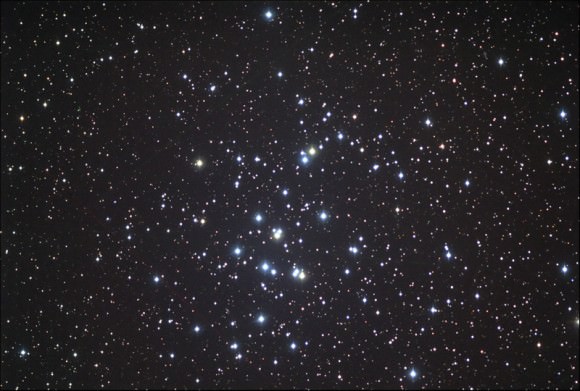There’s a classic science fiction story called Nightfall, written by the late-great Isaac Asimov. It’s the tale of a world with six suns that fill the sky with such brightness that the inhabitants have no concept of night. And then one day, a once-in-a-thousand-years alignment causes all the stars to set at once; and everyone goes crazy!
In another case of science following science fiction, NASA-funded astronomers have discovered planets orbiting within a dense cluster of stars called the Beehive Cluster; a collection of 1,000 stars collected around a common center of gravity – Nightfall worlds?!
Well, not so fast. These worlds are “hot Jupiters;” massive, boiling hot planets that orbit their parent star closer than Mercury in our own Solar System. The two new planets have been designated Pr0201b and Pr0211b after “Praesepe”, another name for the Beehive Cluster. Although they aren’t habitable, the view from those planets in a dense cluster of stars would be awe inspiring, with hundreds of stars within a radius of 12 light-years.
Astronomers had long predicted that planets should be common in star clusters. Consider that our own Solar System probably formed within a star forming complex like the Orion Nebula. Then the individual stars drifted away from each other over time, taking their planets with them. The evolution of the Beehive cluster was different, though, with the mutual gravity of the 1,000+ stars holding themselves together over hundreds of millions of years.
“We are detecting more and more planets that can thrive in diverse and extreme environments like these nearby clusters,” said Mario R. Perez, the NASA astrophysics program scientist in the Origins of Solar Systems Program. “Our galaxy contains more than 1,000 of these open clusters, which potentially can present the physical conditions for harboring many more of these giant planets.”Until now, only two planets had been uncovered around massive stars in star clusters, but none around sun-like stars within these clusters. So the possibility of life was out of the question. These super-jupiters aren’t habitable either, but it’s possible that smaller planets will turn up in time as well.

Beehive Cluster. Image credit: Tom Bash and John Fox/Adam Block/NOAO/AURA/NSFThe planets were discovered by using the 1.5-meter Tillinghast telescope at the Smithsonian Astrophysical Observatory’s Fred Lawrence Whipple Observatory near Amado, Arizona to measure the slight gravitational wobble the orbiting planets induce upon their host stars.
This discovery might help astronomers with another mystery that has been puzzling them for a few years: how can hot Jupiters form? How can a massive planet form so close to their parent star? Instead of forming close, it’s possible that the constant gravitational interactions among stars in young clusters push planets back and forth. Some are spun out into space as rogue planets, while others spiral inward and settle into these tight orbits.
Could there be life on Earth-sized worlds within these clusters? Are there civilizations out there who have never known the concept of night?
Probably not.
According to other researchers who released their findings just a week before the Tillinghast study, planets within star clusters like the Beehive probably aren’t habitable. In a paper titled, Can habitable planets form in clustered environments?, a team of European astronomers considered the environmental effects of star clusters on the formation and evolution of planetary systems. According to their simulations, there are just too many dynamic gravitational encounters with other stars in the cluster for any planet to remain long in the habitable zone.
Source: NASA News Release


No comments:
Post a Comment